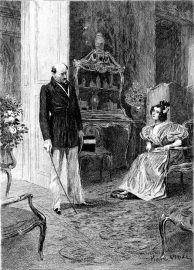
The Illustrious Gaudissart
THE HUMAN COMEDY – Honoré de Balzac Sixth volume of works of Honoré de Balzac edited by widow André Houssiaux, publisher, Hebert and Co, successors, 7 rue Perronet – Paris (1877)
Scenes from Provincial life 
THE ILLUSTRIOUS GAUDISSART
Analysis of the work The illustrious Gaudissard is a weed that grew by chance in the well-ordered bed of Scènes de la vie de province . A new Balzac publisher, Mme Béchet, was planning a launch for this series, which was an original product. A vigorous offensive was planned for December 1833. Ms. Béchet wanted to attract attention by releasing two volumes of the new series at once. A setback occurred. We ran out of material for Volume II. Balzac threw Le Curé de Tours, dubbed “Scène de la vie de province” for the occasion, into the furnace. At the last minute, the printer ran out of copies. Balzac learned of the drama just as he was preparing to meet Madame Hanska in Geneva for a decisive interview. He had to improvise very quickly – “overnight”, he claimed – the new “stopgap” that was to save the situation. He got away with telling a farce that’s a “scene from provincial life” only because it’s set in Vouvray, near Tours. To fill in these few pages, Balzac recalled the variety affairs he had been writing about for two years in La Silhouette, in La Mode or La Caricature. These were quick sketches which, under the general titles of Esquisses parisiennes or Mœurs parisiennes, depicted a number of characters typical of contemporary life: the charlatan, the devotee, the grocer, the minister, the office boy, the Saint-Simonian, the banker, the deputy. Gaudissard, the travelling salesman, the “placier” is none other than one of them. But the portrait was so lively, so ironic, so vividly captured that Gaudissart almost immediately became a household name. While the character may have come out of Balzac’s collection of sketches at the time, the plot itself bears a strong resemblance to the little fabliaux that Balzac was multiplying at the same time in Contes drolatiques : the same peasant flavor, the same mockery, the same fund of common sense.
The story Gaudissart, a well-known travel salesman, sets out on the hunt to peddle his sales skills. He thinks he’s in a conquered land, and that it will be easy to charm the inhabitants of this provincial country, and that everyone will sign up for his life insurance policies. But he had counted on the mischievousness of the people of Touraine: they mocked him without his knowledge by referring him to a madman who was presented to him as an influential banker. When he realizes that he’s been fooled, he’ll go back to his room feeling sheepish and furious. The novel was written by the author in Paris, in November 1832. It’s through Gaudissard’s reappearances in La Comédie Humaine that we see how Balzac, after the fact, discovered the stature and symbolic significance of the merry compère he’d invented to make his readers laugh. The revolution of 1830 made him a household name. To thank him for his services, he was offered the management of a theater on the Boulevard. He became rich, speculated, banked and became a millionaire when he took an interest in the first railway lines. Speculation leads to everything. That’s what Balzac was already saying in a passage in the original edition that was later deleted, and which shows that Balzac, while waving the bells of drollery, didn’t shy away from telling salubrious truths that we’re not wrong to point out.

Gaudissart
The characters Gaudissart Félix: Born in 1792, a traveler’s clerk, a gifted salesman full of verve, who becomes the dupe of a village farce. Sent by the innkeeper to Margaritis, a potential buyer recommended to him, he thinks he’ll find in him more than just a buyer for his insurance policies. Unaware that Margaritis is a mental defective in his spare time, he maintains him, negotiates with him and is duped into plotting against him without his knowledge. Vexed and furious, he left Vouvray with a bitter taste. Mr. Vernier Alias Mitouflet, married, daughter Claire. Former dyer and grenadier in the Imperial Guard, now innkeeper at the Auberge d’Or in Vouvray. In order to get rid of the huckster and play a good joke on him, he recommended that he go and see one of his neighbors, an Italian by the name of Margaritis. This childless married man was half-crazy and sometimes dangerous in his delirium and outbursts. Monsieur Margaritis: Former banker living in Vouvray. Married with no children, he has gradually sunk into madness and is the object of his wife’s every care. On the eve of the day Gaudissart came to Vouvray, Margaritis seemed to have regained a semblance of sanity, a man with his ups and downs.
Source analysis/history according to preface compiled from the complete works of the Comédie Humaine (Volume VIII) published by France Loisirs 1985 under the auspices of the Société des Amis d’Honoré de Balzac.
No Comments